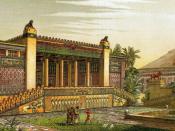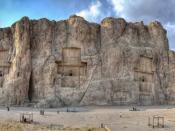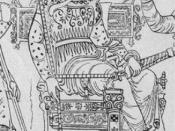The main features of Darius 1 reign were:
Neutralizing early revolts
Military campaigns
Administration of the Empire
Building projects
Neutralizing early revolts
In 522 BC when Darius gained the throne he was faced by major revolts throughout his empire. Sources tell us that the empire was relatively content under the rule of Bardiya, as much of the empire was benefited by tax, military, and religious reforms. In little under a year, Darius was able to quell all the revolts which existed in almost every province of the empire. Darius was merciful to defeated provinces, but thoroughly punished any captured rebel leader, most commonly with death. He deployed his military forces in a well-coordinated and well-timed fashion. This eventually brought peace to the empire and undisputed power to Darius. The revolts were not well-coordinated and Jennifer Lawless suggests that this meant the various peoples wanted to break away from Persian rule rather than create another "Great King".
Darius tells of how he quelled these revolts in the Behistan inscription, he gives considerable detail about the defeat of these rebellions which lay down the rules for any other province considering to revolt, using scare tactics.
Military campaigns
After crushing the various early revolts Darius began his expansion program. Campaigns to the east confirmed gains probably made by Cyrus the Great and added large sections of the northern Indian subcontinent to the list of Persian-controlled provinces. There is some controversy concerning India, as it is not mentioned on the Behistan inscription as a province under the control of the Persian Empire, but is mentioned on an inscription at Persepolis on a statue of Darius.
About 517 BC a Persian force under Otanes captured the Greek Island of Samos, with Lesbos and Chios accepting Persian rule. In approximately 516 BC Darius moved against the Hellespont as a first step toward an attack on the Scythians along the western and northern shores of the Black Sea. George Grote suggests the real strategic purpose behind this move probably was to disrupt and if possible to interrupt Greek trade with the Black Sea area, which supplied much grain to Greece. Darius went into Europe for the first time and campaigned with comparatively little success.
Meanwhile, sometime after 513 BC Persian forces captured the Greek islands of Lemnos and Imbros. In approximately 499 the Ionian Greek cities on the west coast of Asia Minor revolted against Persian rule. At first the rebellion prospered even though it only received limited assistance from the Athenians. Military efforts continued for a few years until 494 BC when Persia was successful. After the revolt Persia replaced many of the tyrants with a form of democracy.
By 491 BC Persian control of the Aegean was firm after the capture of Thasos and Macedonia after a campaign led by Mardonius.
In 490 BC Persia invaded to Greece that led to the great defeat at Marathon. Persia was forced to retreat. Preparations were made for the next invasion, which were on a much larger scale. These plans were interrupted in 486 BC by two events: a serious revolt in Egypt, and the death of Darius.
Administration of the Empire
Darius made his biggest contribution to Persian history with his administrative genius. While Cyrus created an administrative basis Darius perfected this system. Basically Darius kept the same policies used by Cyrus except he added, altered and deleted a few policies to enhance this already high standard of administration.
Darius increased the number of satrapies from approximately 20-30 so that no one satrapy could become too powerful. Each satrap was also appointed various controllers and coordinators to minimize what power they could achieve. Too much power could have led to another revolt for Darius to take care of.
Coinage, weights, and measures were standardized. This created a fairer trade for all and there were strict punishments for those who broke the rules or committed the lie. We have many coins as well as weights and measures that have been found by archaeologists.
Every satrapy was a taxation industry paying differing amounts depending on how wealthy they were. The Naqsh-I Rustam inscription confirms the provinces that paid tribute.
Darius had a reputation as a law giver, however there is little evidence to support him implementing a universal law code. We know laws were important to Darius because he stresses the importance of them in the Behistan inscription.
Darius followed the example of Cyrus in respecting native religious institutions. In Egypt he assumed an Egyptian title and gave active support to the cult. He built a temple to the god Amon, as well as carrying out restoration work on other sanctuaries. In 519 BC he authorized the Jews to rebuild the Temple at Jerusalem, in accordance with the earlier decree of Cyrus.
Building Projects
Darius had one of the greatest building projects of the Empire history, if not the greatest. The style that he used was kept the same until the end of the empire.
In 521 BC Susa was made Darius's administrative capital, he restored fortifications as well as building a residential palace and an audience hall. On the palace there are inscriptions which describe how it was a work of all over the empire, making it a multicultural work.
In Persia Darius founded a new royal capital called Persepolis to replace Pasargadae. At Persepolis he is attributed to the fortifications, apadana, council hall, treasury, and a residential palace are, although not completed in his lifetime. As well as this he also had various building programs at Ecbana and Babylon. We have remains at all the major sites that Darius built at.
Another feature of Darius's building program was the royal road. Which increased communication through the empire incredibly; it was guarded with many garrisons. Herodotus describes these roads in detail giving us distances of how far each stop was. Also the Persepolis tablets refer to royal road from Susa to Persepolis and Sardis to Susa. There was much construction of irrigation systems and drainage of marshes. There is much archaeological evidence supporting this especially near Persepolis and Pasargadae.
In Egypt, Darius ordered the completion of the sewers canal, this allowed for faster trade with Egypt and is proved by an engraved piece of stone, as well as Herodotus.



Darius I
You can make historical parallels: Cyrus created the base, and Darius perfected it; same thing with Peter the Great and Catherine the Great in Russian history. Same thing with Greece: Phillip II created the base, Alexander the Great perfected it.
1 out of 1 people found this comment useful.